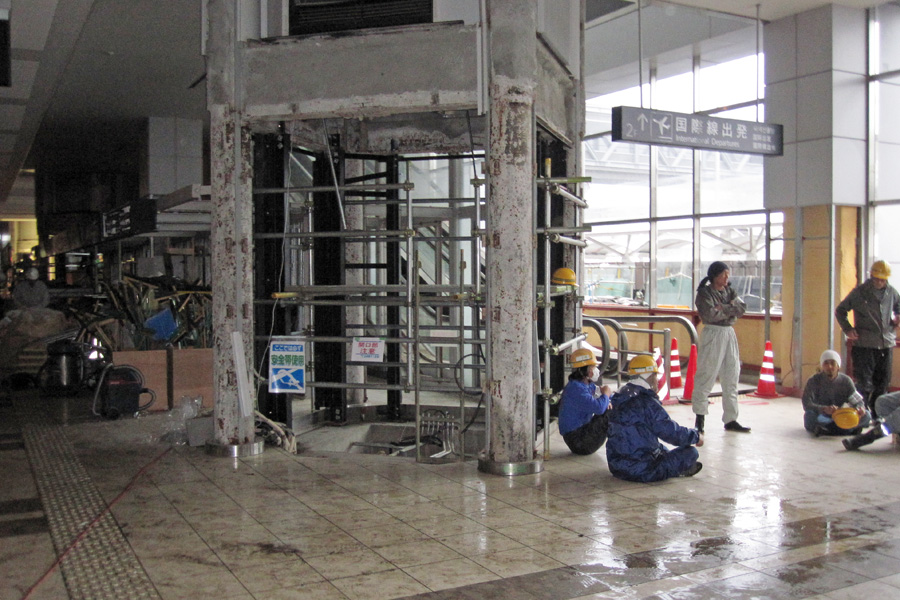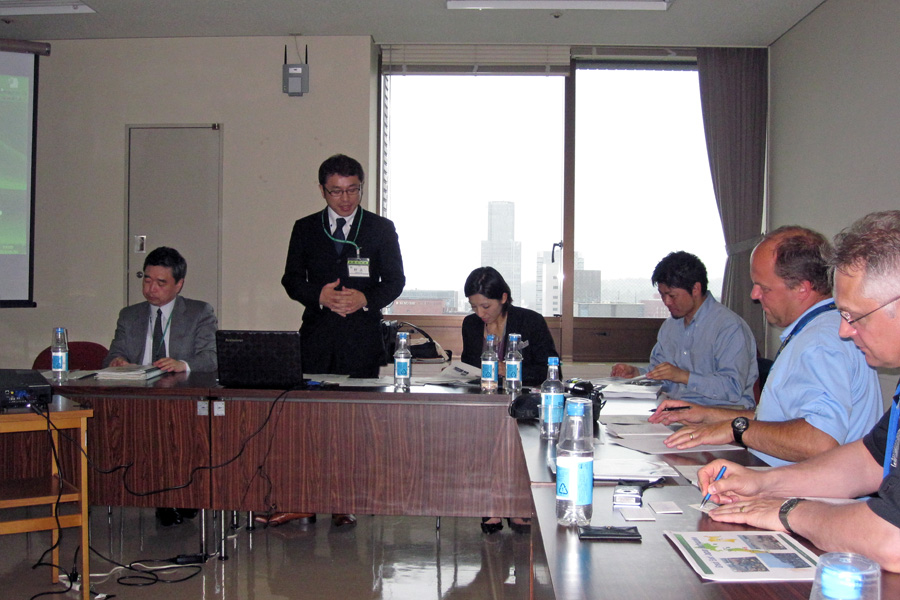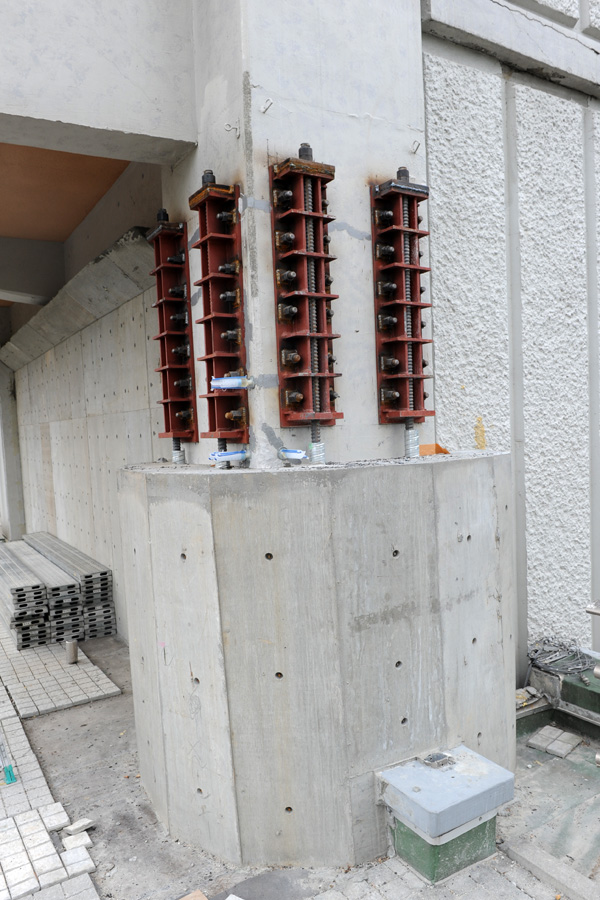Dave Swanson is currently leading a team of structural engineers from the Structural Engineers Association of Washington (SEAW) through Sendai, Japan as part of an earthquake reconnaissance team. The team will study the effects of the Tohoku Earthquake and tsunami on buildings, bridges, ports, and infrastructure. The group will try to learn from this event with an eye toward similarities between the effects of the Tohoku Earthquake and the likely effects of a future earthquake on our Cascadia Subduction Zone (CSZ) here in thePacific Northwest. The CSZ extends from Northern California to Southern British Columbia. Follow the team’s progress as Dave reports back to Reid Middleton throughout the following weeks.
Day 3 – Airport Tour & Public Officials Briefing

The Super Typhoon battering the southern part of Japan brought heavy rains and wind which is causing localized lowland flooding. Many areas near the coastline and within the tsunami zone damaged by the earthquake and tsunami have settled about 1 meter, and are now also contributing to the flooding.

We started our day by traveling to the Sendai Airport for a tour of the Passenger Terminal Building and the Air Cargo Facility. The tsunami devastation here is extensive and severe. Wood-framed buildings were literally scraped off of their foundations, while various types of concrete and steel structures remained standing after the tsunami surge water receded. The vast majority of the damage to the buildings, bridges, and airport infrastructure was attributed to the tsunami and not the earthquake.


At the airport, we met with Mr. Takahashi of the Miyagi Prefectural Government, where we toured the damaged Main Terminal and Air Cargo Buildings. In the main terminal, the tsunami water blew out the lower level exterior walls and glass and interior walls, completely flooding the buildings electrical and mechanical equipment. Emergency generators on the lower level were also damaged by seawater from the tsunami. Many, but not all, passengers and airport workers escaped the tsunami by fleeing to the upper concourse level of the main terminal building where they remained until rescue. Several tsunami surges inundated the entire airport and surrounding buildings with water to levels as high as 5 meters.

We also examined the Air Cargo Building that had caught fire as a result of a hybrid electric car shorting out and exploding while it was being pushed up against the building by the tsunami. The Air Cargo Facility consists of several two story high-bay steel buildings with cargo space on the ground level and office spaces on the second level.

Mr. Kunimichi Fukui, the Senior Managing Director of the Sendai Air Cargo Terminal, told us about his escape and the escape of his staff from the burning air cargo building during brief lulls in the tsunami.
When they learned the tsunami was coming, Mr. Fukui and many of his staff fled to the roof of one of the Air Cargo Buildings. Several of his staff elected to run to the main terminal building, but it was too late as many were swept away by the tsunami. As the tsunami carried debris and cars into the building, a hybrid car’s electrical system shorted out in the salt water and the battery exploded, starting a fire within the high bay area below the roof where Mr. Fukui and many others were gathered. Sensing the need to get off of the roof of the burning Air Cargo Building, Mr. Fukui, and those stranded alongside him, walked through the chest-deep tsunami water and floating debris to an adjacent Air Cargo Building during a lull between tsunami waves. It was a calculated and risky decision, as the water was black and, were they to step in a hole, they would have become submerged and possibly be swept away. Fortunately, the adjacent Air Cargo Building was close. All of the people that were initially with Mr. Fukui on the roof of the building survived. Many others did not.
Day 4 – Tohoku Institute of Technology & Tohoku University Briefings
Day 4 started with a briefing by Dr. Reiji Tanaka, a professor at the Tohoku Institute of Technologies Department of Life Design. Dr. Tanaka and his colleagues provided an overview of the earthquake and impacts to buildings and infrastructure. After the lecture, they answered technical questions by our team on the types of ground motions, and comparisons between the Japanese and United States building codes and structural design practices for tall buildings. It was an interesting and thought-provoking exchange.

The Japanese use a minimum 5 percent base shear design force, and are starting to stiffen their tall buildings to improve seismic performance to make their buildings operational after earthquakes. They are especially concerned about nonstructural performance of building systems (water, power, gas, etc.), as these systems failed in many tall buildings in the region, making those buildings uninhabitable.

In the afternoon, we traveled to the Tohoku University campus for a series of lectures on the seismic performance of several campus buildings that were severely damaged by the 3/11/11 M9.0 earthquake and the subsequent 4/7/11 M7.4 aftershock. We learned about their real-time seismic monitoring and earthquake early warning systems as well as the unique ground motion amplification characteristics of the hilly Tohoku University Campus site.
Spectral accelerations in the 1-second range (impacting a 8-12 story building) recorded on the Tohoku University campus were as much as 3 times greater than ground motions in the lower-lying Sendai region. They are attributing this difference to the variations in topography and depth of soil layers over bedrock in the region. They will be publishing a paper on their unique findings this year. Ultimately, what this might mean is that the Tohoku University campus situated in the hilly areas may need to be micro-zoned for a higher level of design ground motions than buildings in the lower region.

We then toured several education buildings, including the Chemistry Building and the Civil Engineering Building. Both buildings were multi-story concrete buildings constructed in the late 1960’s and had significant structural and nonstructural damage, rendering them unoccupiable. The Chemistry Building had significant damage to a large concrete penthouse structure on its roof that was near collapse. The high ground motions, combined with significant amplifications of these forces at the roof level, overloaded the nonductile concrete penthouse structure. Repairs were not being performed on this building as it will likely be demolished and replaced.


The Civil Engineering building has significant damage to four corner columns at an upper podium level where the building had a significant change in stiffness. These severely damaged columns were retrofited with concrete jackets and long externally bolted and unbonded reinforcing bars anchored to the columns for tension (uplift loads). A pair of new reinforced concrete shear walls infilling window wall openings had been installed since the earthquake. Despite these repairs and retrofits, it is likely that this instructional building will likely be demolished and replaced.

Tomorrow, our team will be traveling toward the coast to observe the tsunami impacts as well as clean-up and recovery efforts.


[…] Reid Our Blog Skip to content Home ← SEAW Tohoku (Japan) Earthquake Reconnaissance: Part 2 […]